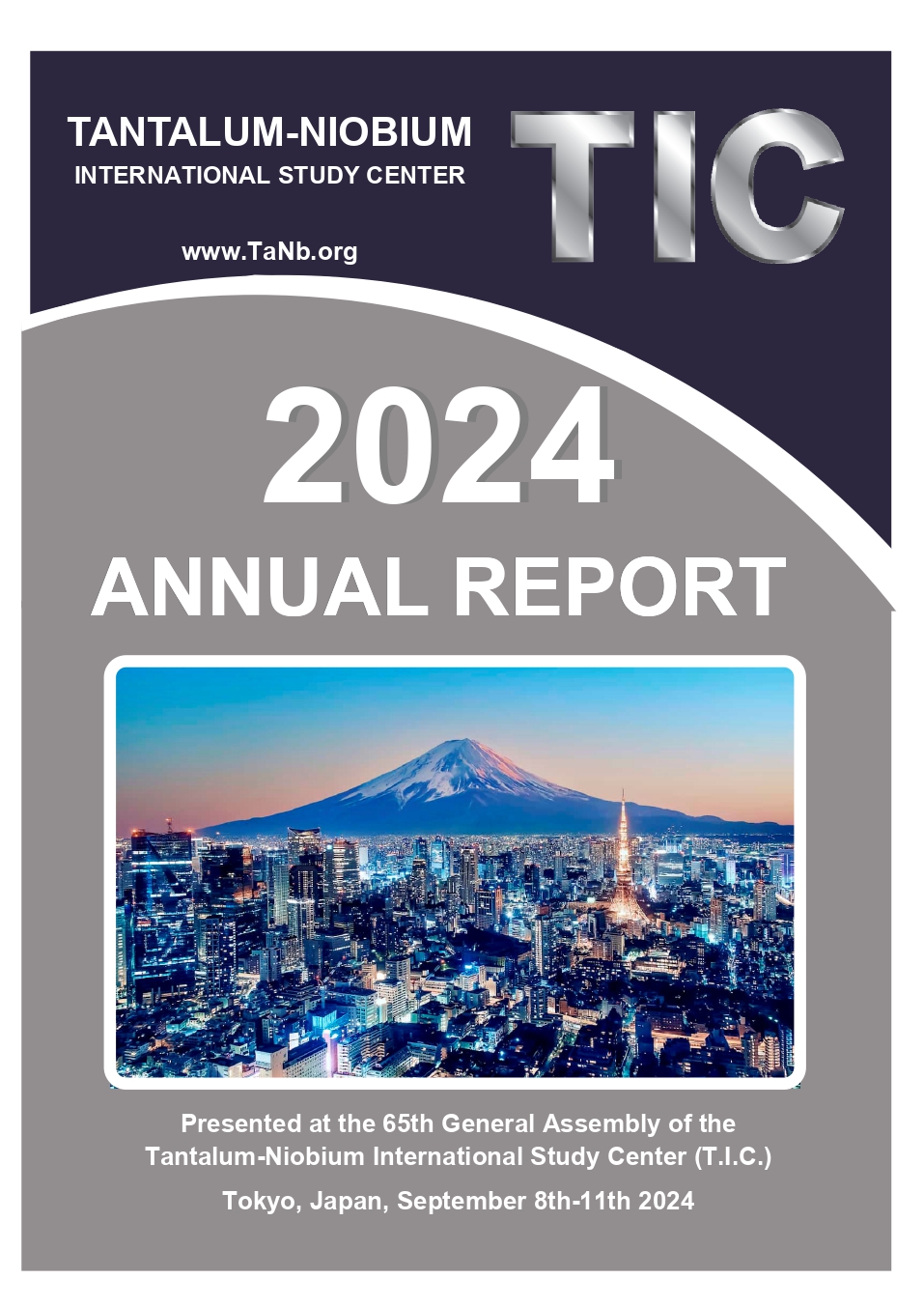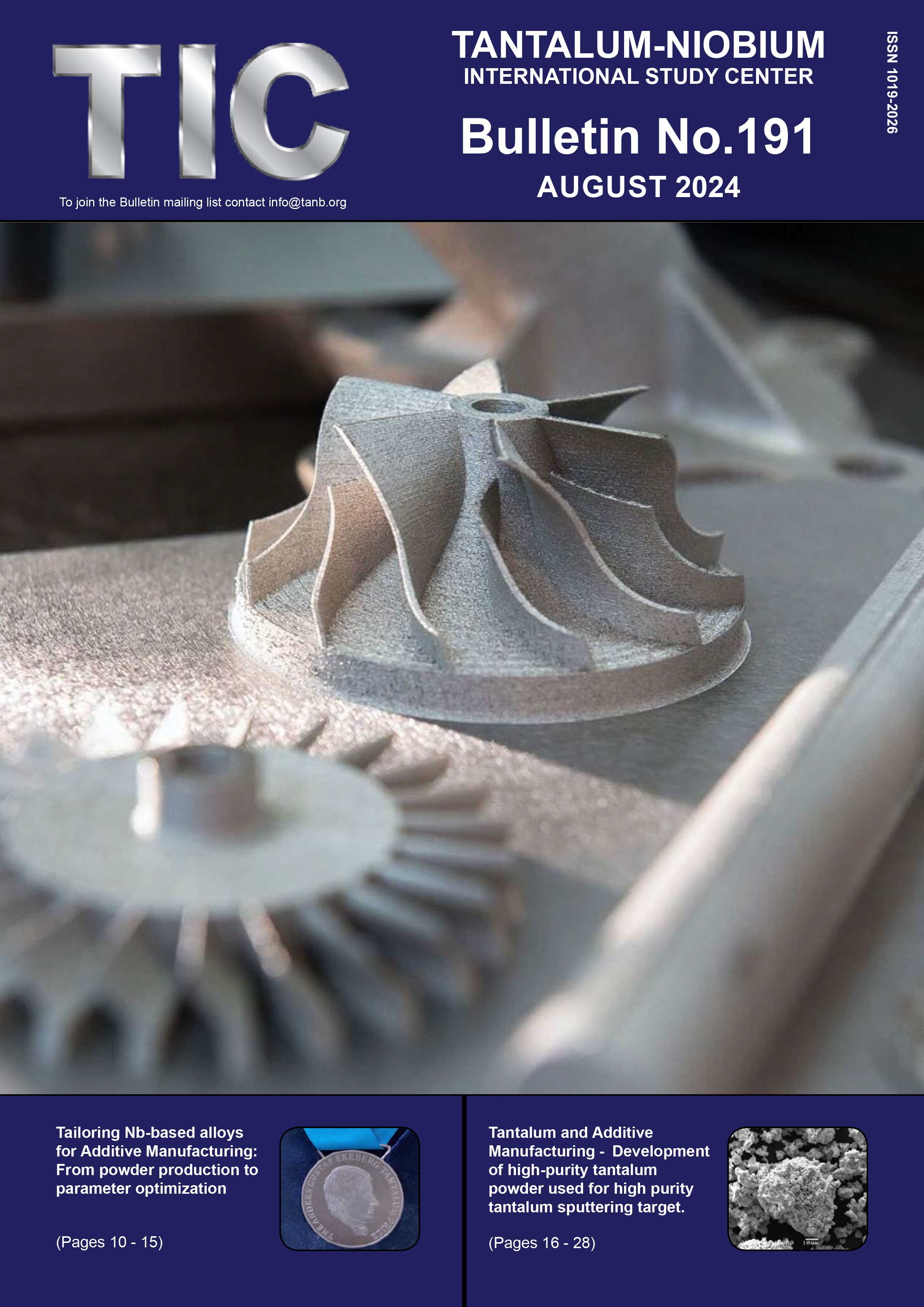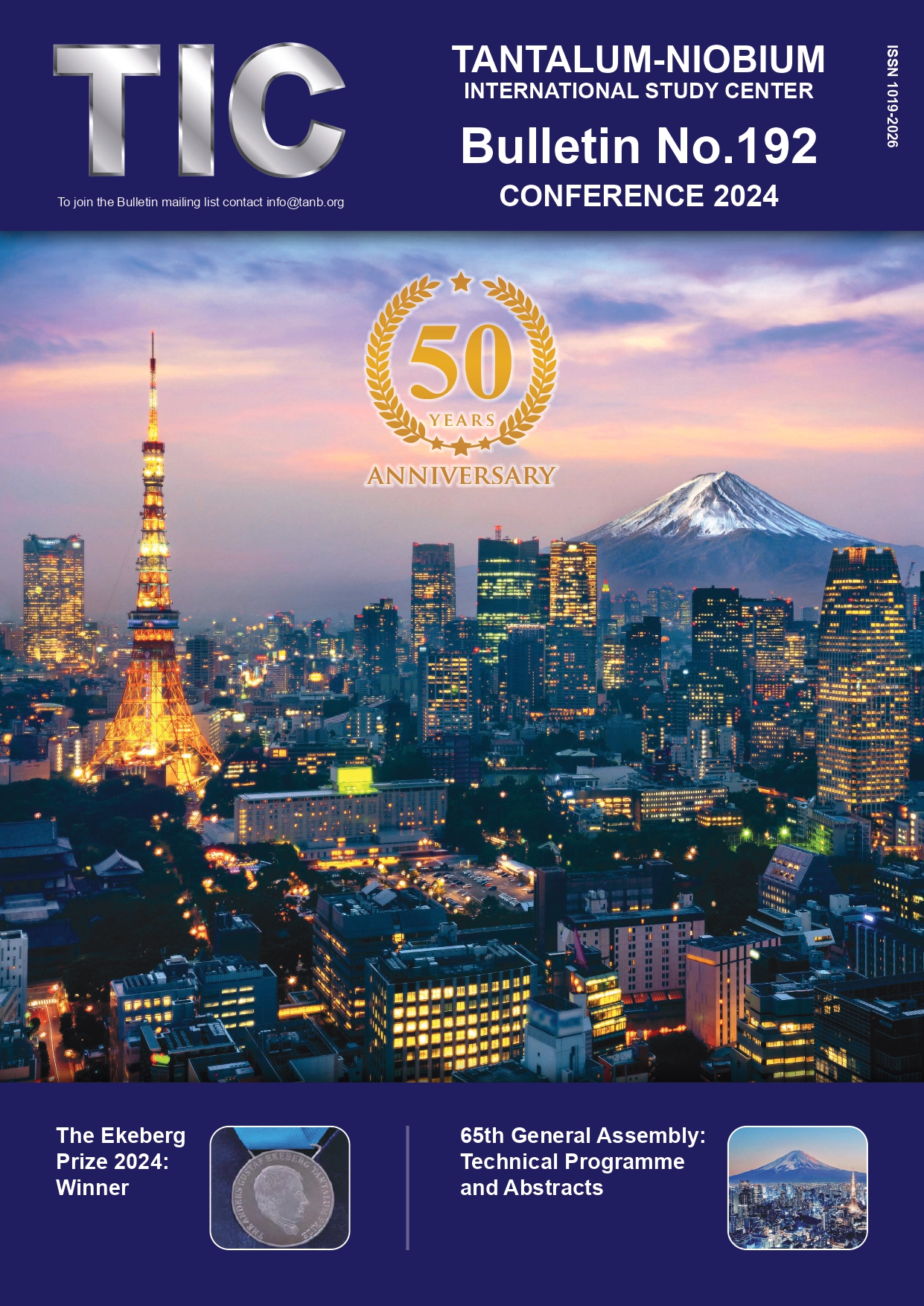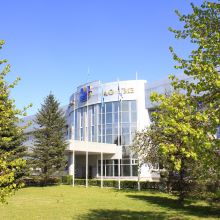History of the T.I.C.
During a business discussion in 1973, Mr Paul Leynen of Geomines in Brussels, Mr Herman Becker-Fluegel of National Resources Trading in New York and Dr Cornelius Herkströter of Billiton Handelsgesellschaft in Lucerne found that they shared concerns about the lack of useful information on tantalum source materials. Following this conversation, the concept of an international organisation of tantalum raw material producers was born. The purpose of the association would be to spread information about tantalum and to promote the common interest and welfare of the producers, especially with public and private authorities, organisations and agencies. They gathered together several representatives of producers to work out the principles and charter of such an organisation.
 |
| The T.I.C.'s first logo |
From their effort, the Tantalum Producers International Study Center was chartered as a non-profit Association under Belgian law on October 24th 1974, with the main objectives ‘to promote and further cooperation between members on matters of research in and studies of all aspects of the tantalum source materials industry and of collecting, disseminating and maintaining statistics and information on any matters affecting that industry’. By the time of the Third General Assembly in Brussels in March 1975, there were 12 members, all raw material producers, representing mining and smelting operations on five continents.
These founder members were: Cobelmin-Zaire, Companhia de Estanho São João Del Rei, Datuk Keramat Smelting, Greenbushes Tin, Hochmetals Africa, Cia. Industrial Fluminense, Makeri Smelting Company, Sociedade Mineira de Marropino, Symetain, Tantalum Mining Corporation of Canada, Thailand Smelting & Refining Company and Zairetain. With ‘estanho’ meaning tin in Portuguese and ‘étain’ meaning tin in French, the strong connection to the tin industry was evident.
Not long thereafter, the General Assembly in September 1975 amended the by-laws of the T.I.C. to include in the membership ‘companies or manufacturers engaged in treating tantalum or columbium-tantalite raw materials, industrial consumers of the products supplied by the former (producers and processors) and commercial intermediaries who provide technical or financial assistance to mining operators of these primary materials, who are not members of the Association’. As a result, the membership grew rapidly, reaching 33 companies by the end of the fifth year and 77 companies in June 1985. These member companies represented all facets of the tantalum industry including source material producers, processors, a major portion of the end-product producers and the principal international companies engaged in the trading of tantalite. In June 1984, at the Twenty-first General Assembly, the name was changed to Tantalum International Study Center, to reflect the wider membership interests of the expanding organisation.
Around 1983, producers and processors of niobium started joining the association. In May 1986, at the Twenty-fifth General Assembly, the Charter was changed to extend the same membership rights to niobium producers, processors and consumers as companies involved in tantalum-related activities. The name of the association was changed to Tantalum-Niobium International Study Center.
 |
| The T.I.C.'s second logo |
In 1994, twenty years after its foundation, the association was encountering some financial difficulties. Consolidation and integration, combined with several years of difficult economic circumstances for non-ferrous metals in general, had brought the number of members down to 50. That year, Cabot, H.C. Starck, Gwalia and Thai Tantalum donated 40000 US Dollars to the T.I.C. ‘Prom Fund’ to finance the promotion of tantalum and niobium. Associate membership was also introduced, in an effort to widen the membership base. Finally, the Third International Symposium was organised in Goslar, Germany in 1995. Its enormous success helped to improve the financial situation of the association.
By 1997, business was looking up, with the ‘age of internet’ leading to huge investments world-wide. The T.I.C. followed suit: in June 1998, the association had its own email address and in March 1999, the website was born. The appearance of the website was updated in July 2009 before a complete overhaul end 2015, including rebranding of the association by the adoption of a new logo.
In 2000, all five major applications of tantalum reached a peak in demand simultaneously:
- industrial gas turbines (IGT) for power generation
- cutting tools containing carbides
- automotive applications
- corrosion-resistant tanks and other applications in the chemical industry
- mobile phones and high-speed internet devices in the electronics industry.
Demand was high but speculation made the market look even bigger than it was, and prices escalated. This context of high demand also brought to light the issue of ‘conflict coltan’ from central Africa.
Shortly afterwards, the ‘bubble’ burst. Reacting to the increased prices and apparent shortage of supply, the electronics industry designed out tantalum capacitors wherever possible. To date, the tantalum industry is still reconsolidating its position. The challenge is now to look for new opportunities, to increase demand.
Over the years, the tantalum industry has also been faced with several other challenges, related to the transport of raw materials, the enforcement of the REACH regulations and the ongoing issues related to sourcing of minerals from the ‘conflict regions’ of central Africa.
 |
| The T.I.C.'s current logo |
In 2003, a Working Group on the transport of raw materials with naturally-occurring low levels of radioactivity was formed under the aegis of the T.I.C. In 2005, a consultant, Dr Doug Chambers of SENES, was employed by the T.I.C. to write a final report for submission to the IAEA, with the goal of changing the current regulations for the handling of tantalum raw materials. In 2014, the 'T.I.C. Policy on Transport of Radioactive Materials' was adopted by the Fifty-fifth General Assembly, held in New York.
In 2009, the T.I.C. established a Working Group on Tantalum and Niobium Mining. This Working Group was constituted of five members of the Executive Committee, together with the Technical Promotion Officer and the Secretary General. The objectives of the Working Group were to promote the tantalum and niobium industries, to explore the issues related to the mining of their minerals on a world-wide scale and to help to improve the standards of artisanal and small-scale mining (ASM) operations. In particular, the Group developed a policy of due diligence in the form of transparency and traceability of raw materials along the supply chain. The 'Artisanal and Small Scale Mining Policy' was adopted by the Fiftieth General Assembly, held in Tallinn in 2009.
During this time, the niobium industry created its own market by promoting the use of ferro-niobium in steel. This is by far the major application. Other important applications include powder for capacitors, alloys for superconducting applications, alloys for turbine blades… The niobium industry is characterised by a long-term perspective, with stable pricing and stable supply.
The business of the T.I.C. has been carried out by the Secretariat located in or near Brussels, first in a small attic sub-let from a larger organisation at 1, Rue aux Laines, 1000 Brussels, then, from 1983 until 2008, in its own office in the International Association Centre, 40 Rue Washington, 1050 Brussels, then, since 2008, at Chaussée de Louvain 490, 1380 Lasne.
The first Secretary General of the T.I.C. was Mrs Jan Goodyear. She left in 1977, when she moved abroad. The affairs of the T.I.C. were managed by Mrs Judy Wickens for the following 30 years, until her retirement. In 2007, Ms Emma Wickens held the position until 2023 when Mrs Heather Margerison has taken over the position.
In 1985, the position of Technical Promotion Officer was created. The title was later changed to Technical Officer. It has been occupied successively by:
- Mr Andrew Jones from 1985 to 1989
- Mr Rod Tolley from 1989 to 1993
- Dr George Korinek from 1993 to 1998
- Mr C. Edward (Ed) Mosheim from 1999 to 2003
- Mr William Serjak from 2003 to 2005
- Mr Ulric Schwela from 2005 to 2016
- Mr David Knudson from 2016 to 2021
- Mr Ian Margerison since 2021
In 2015, the position of Director to the T.I.C. was created. Mr Roland Chavasse joined the association on January 1st 2016 as first Director to the T.I.C. The position of Director ceased to exist in October 2020.
At that point in time, the T.I.C. created a position of Executive Marketing Manager (EMM), which Mr Roland Chavasse occupied until November 2021. Since then, the EMM position has been occupied by Mr Ian Margerison (together with the position of Technical Officer).
The T.I.C. ‘Bulletin’ has been published quarterly since February 1975 starting as a simple four-page issue which gradually expanded into a regular eight-page publication. In black and white for the first 71 issues, colour was introduced in September 1992. Issue 146 of June 2011 was the last to be distributed in hard copy. Since September 2011, the Bulletin has been published in electronic format.
There have been over 180 issues to date. In addition to providing in print some of the presentations made at the T.I.C. meetings and reporting on the activities of the T.I.C., articles have been published covering many facets of the tantalum and niobium businesses from mining to the use in end-products, as well as periodic analyses of the supply and demand conditions of the market. The Bulletin was edited by Mr Graham Brown from 1975 to 1985. After that date, the Technical Promotion Officers took over the role and, later, the Bulletin was edited by the Secretary General, then the Director, then the Executive Marketing Manager.
At first, two General Assemblies were held in each year. The first six took place in Brussels, where precious help with the organisation was provided by Mr Paul Leynen. Then, in 1977, a meeting was held in Winnipeg, Canada, where the T.I.C. was invited by Mr Herman Becker-Fluegel to tour the mine of the Tantalum Mining Corporation of Canada (Tanco) at Bernic Lake.
Thereafter until 1987 there continued to be two Assemblies in each year, one in Brussels and one in another part of the world so that a visit to a mine or plant could be included in the conference programme, alongside the administrative business and the presentation of technical and scientific papers by distinguished and knowledgeable speakers.
In 1987, the Charter was modified to allow the association to choose to hold only one General Assembly per calendar year, while also permitting a greater number of meetings if these were required. Since then, one Assembly has been held each year, but the tradition of seeing an appropriate facility is maintained and the venue is different each year, thanks to our many hosts! A general principle of rotation around the world every three years (Europe/Africa, North/South America, Asia/Australia) means that the Assembly passes regularly close to the home country of all members. Attendance at these meetings has exploded from a mere 46 at Tanco in 1977 to over 200 in recent years, demonstrating the rapid development of the T.I.C. Seven of the General Assemblies have been held in conjunction with an International Symposium, a longer event with an increased number of technical papers.
The association is run by its Executive Committee. This Committee has always reflected the range of activities of the members, and it covers the geographic spread of the membership, too. Presidents have been drawn from all sectors of the industry and from many parts of the world. The term of office is one year but it can be renewed.
Since its inception, the Tantalum-Niobium International Study Center has grown and developed to encompass the changing nature of the tantalum and niobium industries and will continue in the same spirit in facing future challenges.





